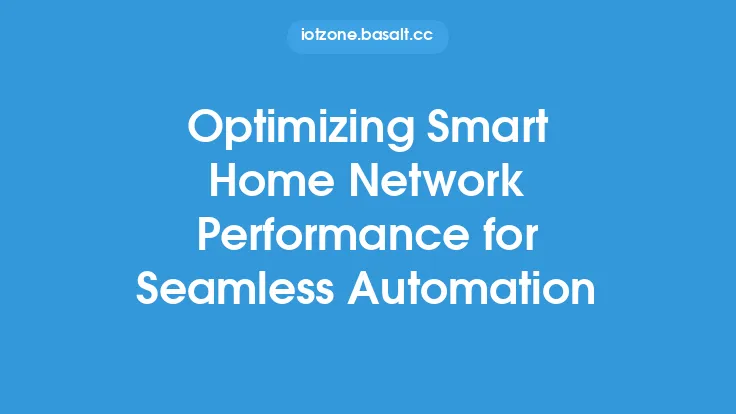The increasing demand for Internet of Things (IoT) devices has led to a growing need for optimized network performance. IoT networks are expected to handle a vast amount of data from various devices, and any latency or throughput issues can significantly impact the overall performance of the system. Optimizing IoT network performance is crucial to ensure low latency and high throughput, which are essential for many IoT applications, such as real-time monitoring, smart homes, and industrial automation.
Introduction to IoT Network Performance Optimization
IoT network performance optimization involves a combination of techniques and strategies to improve the efficiency and reliability of data transmission. This includes optimizing network protocols, device configuration, and network architecture. The goal is to minimize latency, maximize throughput, and ensure reliable connectivity. To achieve this, it's essential to understand the factors that affect IoT network performance, such as network congestion, packet loss, and interference.
Factors Affecting IoT Network Performance
Several factors can impact IoT network performance, including:
- Network congestion: As the number of devices increases, network congestion becomes a significant issue. This can lead to packet loss, latency, and reduced throughput.
- Packet loss: Packet loss occurs when data packets are lost or corrupted during transmission. This can significantly impact network performance, especially in applications that require real-time data transmission.
- Interference: Interference from other devices or networks can cause packet loss, latency, and reduced throughput.
- Device configuration: Device configuration, such as transmission power, data rate, and packet size, can significantly impact network performance.
- Network architecture: Network architecture, including the type of network topology, can impact network performance.
Optimizing IoT Network Protocols
IoT network protocols, such as CoAP, MQTT, and HTTP, play a crucial role in determining network performance. Optimizing these protocols can help reduce latency and improve throughput. Some techniques for optimizing IoT network protocols include:
- Using protocol headers and footers efficiently
- Implementing protocol compression and caching
- Optimizing protocol parameters, such as packet size and transmission interval
- Using protocol-specific features, such as CoAP's observe feature, to reduce latency and improve throughput
Device Configuration and Optimization
Device configuration and optimization are critical to ensuring low latency and high throughput. Some techniques for optimizing device configuration include:
- Optimizing transmission power and data rate
- Adjusting packet size and transmission interval
- Implementing device-specific features, such as sleep modes and low-power modes
- Using device management protocols, such as LWM2M, to monitor and manage device performance
Network Architecture and Topology
Network architecture and topology can significantly impact IoT network performance. Some techniques for optimizing network architecture and topology include:
- Using a mesh network topology to improve reliability and reduce latency
- Implementing network segmentation to reduce congestion and improve security
- Using network routing protocols, such as RPL, to optimize data transmission
- Implementing quality of service (QoS) policies to prioritize critical traffic
Quality of Service (QoS) and Traffic Management
QoS and traffic management are essential for ensuring low latency and high throughput in IoT networks. Some techniques for implementing QoS and traffic management include:
- Prioritizing critical traffic, such as real-time monitoring data
- Implementing traffic shaping and policing to reduce congestion
- Using QoS protocols, such as DiffServ, to ensure reliable and efficient data transmission
- Implementing traffic monitoring and analysis to identify and resolve performance issues
Network Monitoring and Analysis
Network monitoring and analysis are critical to identifying and resolving performance issues in IoT networks. Some techniques for network monitoring and analysis include:
- Implementing network monitoring protocols, such as SNMP, to collect performance data
- Using network analysis tools, such as Wireshark, to analyze traffic patterns and identify performance issues
- Implementing machine learning algorithms to predict and prevent performance issues
- Using cloud-based network management platforms to monitor and manage network performance
Best Practices for Optimizing IoT Network Performance
To optimize IoT network performance, it's essential to follow best practices, such as:
- Conducting thorough network planning and design
- Implementing robust network security measures
- Monitoring and analyzing network performance regularly
- Optimizing device configuration and network protocols
- Implementing QoS and traffic management policies
- Using network management platforms to monitor and manage network performance
Conclusion
Optimizing IoT network performance is crucial to ensuring low latency and high throughput. By understanding the factors that affect IoT network performance, optimizing network protocols, device configuration, and network architecture, and implementing QoS and traffic management policies, it's possible to ensure reliable and efficient data transmission. By following best practices and using network monitoring and analysis tools, it's possible to identify and resolve performance issues, ensuring optimal IoT network performance. As the IoT continues to grow and evolve, optimizing network performance will become increasingly important to ensure the reliability and efficiency of IoT applications.





